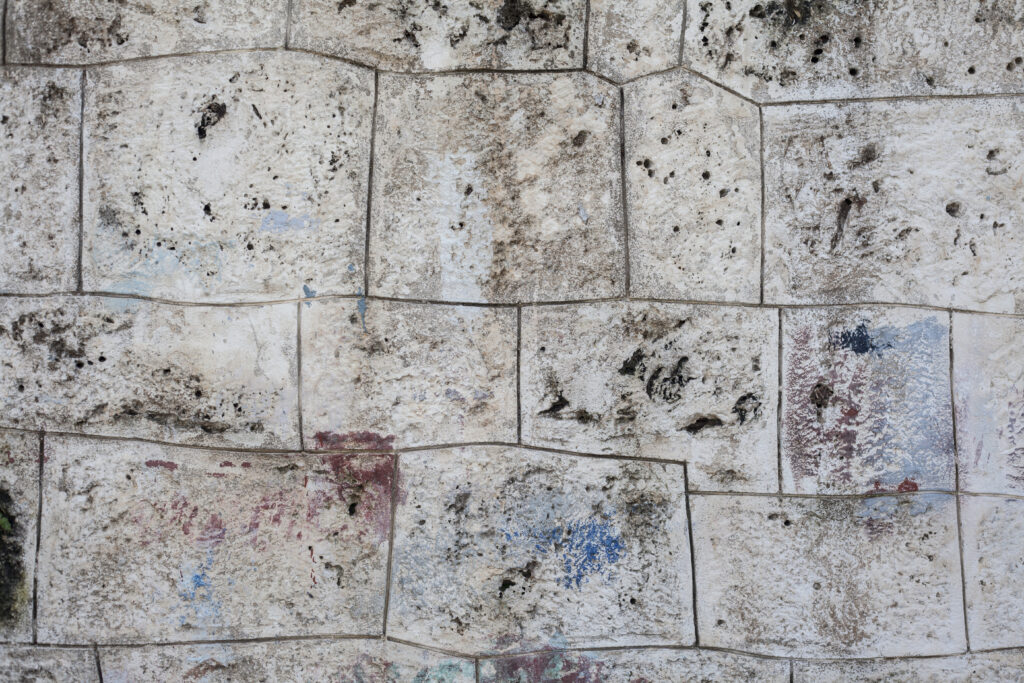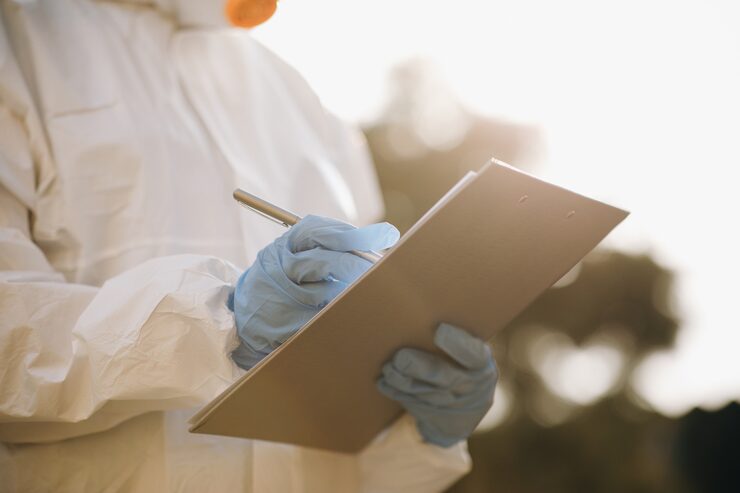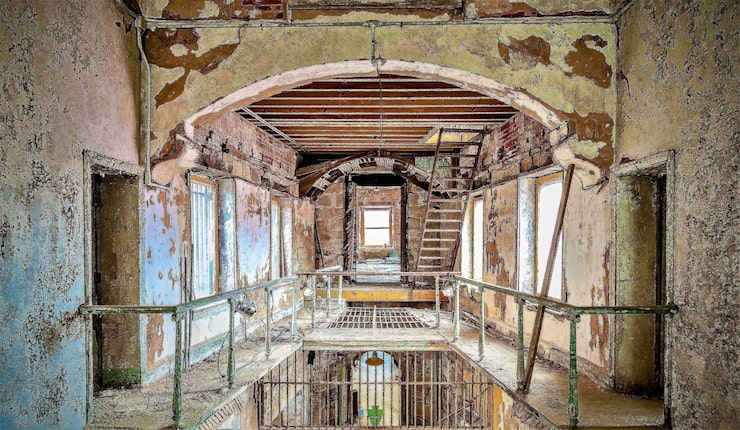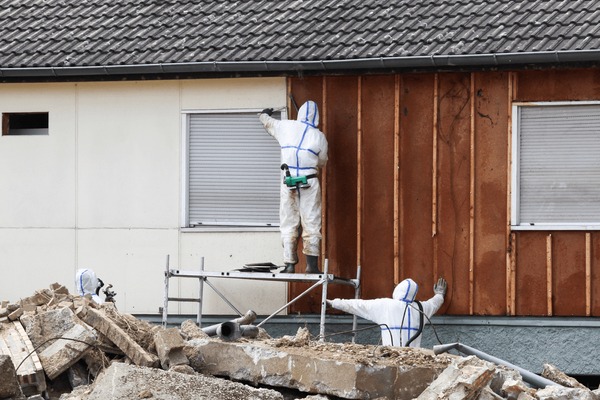In commonly found flooring materials like lino or linoleum, carpet, or vinyl flooring, asbestos traces can be discovered through proper testing. While doing DIY renovation works, homeowners often can tear the lino, carpet, or vinyl flooring without apprehending the risks associated with disturbing the asbestos. But why was asbestos used in these flooring materials? Let’s look at the facts behind it.
Why Asbestos Was Used in Flooring Materials
In Australia, Asbestos was considered one of the key construction materials before the 1980s. Asbestos-containing flooring materials were used because it was durable, heat-resistant, and sturdy alternatives in the construction industry. Currently, although including asbestos in building materials has been banned in Australia, asbestos can still be found in buildings built before the 1980s. However, in old houses in Australia, especially those built between the 1950s and 1980s, asbestos can still be found within textured ceilings, walls, and sidings to different types of flooring.
Asbestos can be discoverable in certain flooring materials, such as:
- Vinyl tiles and sheet flooring, particularly in the back siding
- Lino with asbestos is also a common phenomenon
- Asbestos in carpet underlay can also be found if properly
High-Risk Flooring Materials Found in Australian Homes
Certain flooring materials, like vinyl flooring, linoleum, and carpet containing asbestos, can impose severe health risks. Here is a comprehensive table depicting different types of flooring in older Australian properties and the level of asbestos risks that these materials can pose.
| Flooring Type | Level of Asbestos Risk | Common in Homes Built | Signs of Contamination |
|---|---|---|---|
| Sheet Vinyl With Backing | Very High | 1950s–1980s | Peeling edges and black edges |
| Vinyl Tiles (9” or 12”) | High | 1960s–1980s | Tiles are becoming brittle and stiff |
| Carpet Underlay | Medium–High | 1950s–1970s | Musty smell and exposed fibrous jute backing |
| True Lino | Medium | 1940s–1970s | Thick, rubbery surface |
Table 1: Common Flooring Materials That Can Contain Asbestos
Hidden Hazards Beneath Your Flooring
There might be asbestos in the carpet, even if it looks clean. Not all floors are equally contaminated with asbestos. However, it is important to know the hazards underneath the flooring.
Asbestos Vinyl Tiles
Vinyl asbestos tiles are generally found in 9 x 9 or 12 x 12 square tiles. Asbestos was directly combined with vinyl to increase the strength and durability of the tiles. If left undisturbed, there is less possibility of fibre damage. Asbestos can be found in the glue underneath the vinyl tiles. However, during asbestos remediation, incorrect handling of asbestos in vinyl flooring can lead to a health hazard.
Asbestos in Vinyl Sheet Flooring
Asbestos can be discovered in Vinyl sheet flooring, which is generally installed in kitchens and bathrooms. Here, the asbestos can be observed in the backing and the lining. The sheet, carrying 100% white asbestos, can be easily collapsed by hand. Therefore, there is an increased risk of asbestos exposure while handling this flooring.
Asbestos in Lino Flooring
Asbestos can be found in the lino flooring, especially in the adhesive called mastic, which is used to install lino flooring. Many people also consider that there are certain kinds of lino with asbestos material, which helps in making the flooring sturdy and enduring.
Handling these floor materials without proper protection or prior knowledge of contamination can lead to the release of harmful airborne fibres of aluminium. Here are some common risks of asbestos contamination that can happen during general renovation activities.
| Activity | Fibre Release Risk | What Happens in This Case |
|---|---|---|
| Scraping up vinyl sheets | High | The asbestos-containing backing can be scrambled due to improper handling |
| Pulling up carpet and underlay | Medium to High | Can disturb crumbly and hidden lino |
| Sanding tile adhesive | Extreme | Releases microscopic airborne asbestos fibres |
| Removing tiles with heat tools | High | Tiles can break and reduce the fibres |
Table 2: Risk of Fibre Release During Common Renovation Activities
How to Tell if Your Flooring Contains Asbestos
Asbestos in vinyl flooring and carpet underlay is highly common, specifically in older homes. From flooring adhesives to vinyl sheets, asbestos can be found in different parts of flooring materials.
The only ideal way to identify asbestos in flooring is by conducting lab testing of the area professionally. However, you can also identify whether your flooring has been contaminated with asbestos or not. Below are some indications that can potentially indicate asbestos contamination.
- Age of the House: If your property was built before 1990, there is a serious chance of having traces of asbestos fibres in the flooring materials.
- Discolouration or Cracking: If you see your tiles going discoloured or cracking in the panels of tiles, there is a chance of asbestos presence. Furthermore, oily, greasy flooring can also indicate it.
- Black or Dark Brown Adhesives: Adhesives can turn black or dark brown if asbestos is present underneath the flooring. Above all, you should not assume safety just by the appearance underneath the flooring. Therefore, it is crucial to consider professional testing for developing asbestos presence.
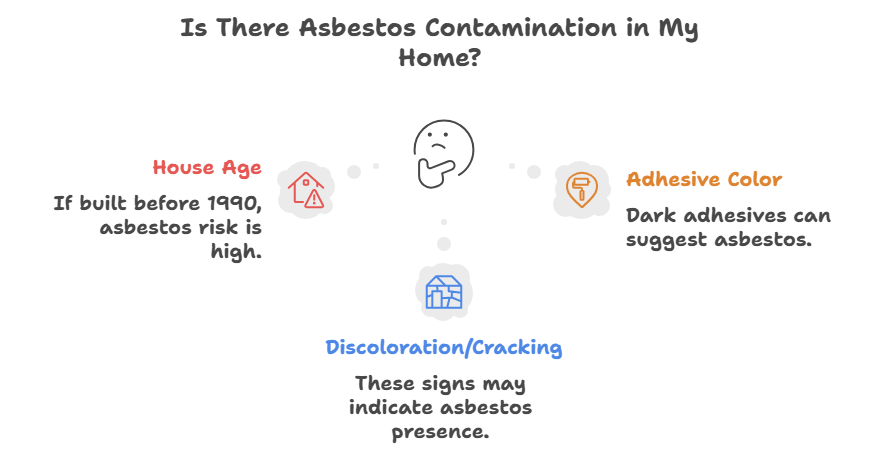
Safe Steps for Dealing with Suspected Asbestos in Flooring
While dealing with potential asbestos contamination in the flooring materials, one should properly follow the safety steps to avoid unwanted asbestos exposure. Follow this guidance to ensure what to do and what not to do. The practice of safe remediation is crucial to assessing the importance of asbestos management in properties.
| What to Do | What Not to Do |
|---|---|
| Ceasing the work immediately to avoid asbestos contamination. | Do not vacuum, sweep, or disturb the area. |
| Consult a professional and certified expert and ask them to collect the sample for testing the asbestos present in the area. | Do not cut, rip, or scrape the flaky old flooring. Do not remove the vinyl asbestos tiles by hand. |
| If the lab test comes back affirmative, it is crucial to have licensed asbestos remediation. | Do not conduct an unlicensed site assessment. |
Table 3: Dos and Don’ts While Handling Asbestos Underneath the Flooring
Final Thoughts
Testing for asbestos presence is crucial to identify whether there is asbestos underneath the flooring made of lino, carpet, and vinyl sheet flooring. Asbestos in vinyl flooring can be easily overlooked, but it should not be ignored because of the hazards that can impact your health. Asbestos testing is quick and affordable. Plus, it is also important for your and your family’s safety, so you can have peace of mind even during renovations.
Consult Professional Asbestos Testing in Your House to Identify Asbestos Exposure!
Want to renovate your house’s flooring? Contact with certified asbestos testers who can evaluate the site properly to avoid asbestos disturbance.
Frequently Asked Questions
Is It Safe to Dispose Old Lino Myself?
No, it is absolutely not safe to dispose old lino yourself because there can be asbestos in the lino flooring. If you try to dispose old lino without proper protective gears, you can end up inhaling asbestos, which will lead to severe health issues.
How to Check Whether the Asbestos Testing Company is Genuine?
Look for Class A + Class B + Supervisor license to evaluate the genuineness of asbestos testing individuals. Without this licensing, the asbestos withdrawal will not be certified.
Can Scraps of Vinyl Tiles Impose Health Risks?
Yes. Even the smallest disturbance can lead to significant health hazards. The airborne tile particles can lead to respiratory issues like mesothelioma and lung cancer if inhaled directly. Without proper protective gear, touching or disturbing old vinyl tiles can impose health risks.


